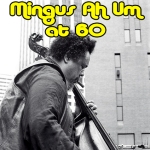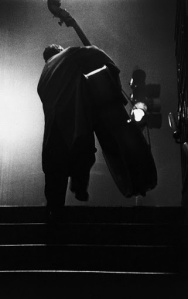Mingus and the Chill of Death

 In his autobiography, Beneath the Underdog, jazz musician Charles Mingus recounts his hatred of being ignored during his bass solos. When it was finally his turn to enter the foreground, suddenly musicians and audience members alike found drinks, food, conversations, and everything else more important. However, this small, and somewhat ironic, anecdote of Mingus’s relationship with the jazz community has now become a foreshadowing of his current status in sound studies–but no longer! This series–featuring myself (Earl Brooks), Brittnay Proctor, Jessica Teague, and Nichole Rustin-Paschal— re/hears, re/sounds and re/mixes the contributions of Mingus for his ingenious approach to jazz performance and composition as well as his far-reaching theorizations of sound in relation to liberation and social equality, all in honor of the 60th anniversary of Mingus’s sublimely idiosyncratic album Mingus Ah Um this month. The final installment of this series presents Nichole Rustin-Paschal and her gripping reflection on jazz, death, and mourning. Her opening line requires no introduction: “There was a time when I believed that Mingus was haunting me.” You can catch up with the full series by clicking here.–Guest Editor Earl Brooks
In his autobiography, Beneath the Underdog, jazz musician Charles Mingus recounts his hatred of being ignored during his bass solos. When it was finally his turn to enter the foreground, suddenly musicians and audience members alike found drinks, food, conversations, and everything else more important. However, this small, and somewhat ironic, anecdote of Mingus’s relationship with the jazz community has now become a foreshadowing of his current status in sound studies–but no longer! This series–featuring myself (Earl Brooks), Brittnay Proctor, Jessica Teague, and Nichole Rustin-Paschal— re/hears, re/sounds and re/mixes the contributions of Mingus for his ingenious approach to jazz performance and composition as well as his far-reaching theorizations of sound in relation to liberation and social equality, all in honor of the 60th anniversary of Mingus’s sublimely idiosyncratic album Mingus Ah Um this month. The final installment of this series presents Nichole Rustin-Paschal and her gripping reflection on jazz, death, and mourning. Her opening line requires no introduction: “There was a time when I believed that Mingus was haunting me.” You can catch up with the full series by clicking here.–Guest Editor Earl Brooks

Image courtesy of author
There was a time when I believed that Mingus was haunting me. In the small college town where I was then living, I would occasionally see a man with Mingus’s profile, wearing a black hat, leather vest, and sunglasses, in a wheelchair out and about. He was always alone. Mingus had spent the last year of his life increasingly dependent on a wheelchair as the ALS stripped him of his motility. There is a joyous photo of him in his wheelchair, hair in a riot of curls, mouth open in uproarious laughter with Joni Mitchell embracing him from behind, her face aglow with an open-mouthed smile. I can imagine the sound, caught perhaps during a break as they were collaborating on Mingus, his last effort and the album Mitchell said killed her career. Yes, God Must Be a Boogie Man, sending me messages to write and write some more through the sight of this man looking so much like Mingus. Never did I see him with anyone, he was always a solitary figure traveling the main streets. I do not know if he was real.
Listen to Mingus, and you can eavesdrop on his 53rd birthday party (though he thought he was actually 54), his end of life plan (to be buried in India), and his Midas touch, through sound clips from events and interviews happening years earlier, interspersed among the songs. In his quick, low rumbling of voice Mingus proclaimed that he “was lucky, man. Blessed by God.” Mingus was released after his death, the sounds of celebration, funerary plans, and gratitude leading to the final performance, Goodbye Pork Pie Hat.
Mitchell’s lyrics tell both the story of Mingus’s elegy for Lester Young and his own efforts to ward off death among the healers in Cuernavaca, Mexico. It is a story about the black musician as underdog, first reviled, then celebrated with dancing in the street. It is a story about the threat of interracial love and the promise of children. “Love is never easy street,” Mitchell writes, but still, we dance, make music, hope.
The only other time I have felt the dead come to me was some years later while I was rushing through Penn Station to catch my train. The sight of a man sitting cross-legged by one of the columns, surrounded by his belongings, nearly stopped me in my tracks. Surely, that couldn’t be my father, looking at me so calmly and certainly in the crush of Penn Station? A Hoodoo Hollerin’ Ghost he was not, but he was a haint sent to calm me, I’m sure of it. My father had died not too long before. I saw him there and he saw me. Every time I hear Horace Silver’s “Song for My Father,” cliche as it may seem, I think of him, the Mayor of Bum’s Square in Harlem.
Lithe and tall, brown-skinned and handsome, my father loved music and to dance, he dreamed of Egypt and having a son, loved his three daughters and shared his wisdom with them, found a soul mate to get clean with. In a frame by my desk I keep two pictures of us; in both we mirror each other’s expressions. In the first, I may be three and he twenty-two. We are both serious. In the second, he is about the age I am now and we are sitting side by side, smiling, at my baby brother’s first birthday party. They shared a birthday month. I had already given my father is own gift, Francis Paudras’s biography of Bud Powell, his favorite jazz musician. It was the last gift I gave him.
It strikes me that with both these haunting, despite their love of music, I felt closest to them through sightings of them–the clarity with which I could imagine them in settings so seemingly out of character–Mingus in Western Mass., my father south of 125th St.–resonated with me more than any particular piece of music that I could associate with them. For each, death came with physical decline and, for two vibrantly garrulous people, the loss of speech. Each had a way of speaking in tones that were intimate and confiding, even as they reveled in having an audience. For language and voice to fail as they came closer to death, must have been as unbearable for them as it was for we who loved them, and hoped to hear them utter our names, say they loved us, one last time. Buddy Collette speaks of seeing Mingus in his final days and the difficulty of looking at his eyes, which were expressive of pain, despair, and longing. He felt Mingus was imploring him to do something, but he did not know what. Helplessness. My father spent his last weeks in the hospital and with each visit, I could see him turn inward, chasing down memories only he could see. For both, a yearning for a golden age, time past; for we who remain, their absence remolding the shape of things to come.
How do artists teach us to mourn? We are accustomed to thinking about the Second Line, a New Orleans tradition, celebrating the passing on of a loved one. Mourning is public and communal, dancers and musicians moving together to escort the dead to their rest. We think of elegies penned by close friends of other artists, such as Dizzy Gillespie’s “I Remember Clifford,” Miles Davis’ “He Loved Him Madly,” Mingus’s “Goodbye Pork-Pie Hat”—the pain becoming a standard, its changes reimagined, its melody a constant. How do hauntings give color to the music and the memories?

“Ghost in the Machine,” close-up of jazz bass, image by Flickr User RubyT (CC BY-NC-ND 2.0)
The death that looms so heavily over jazz of the postwar era is that of Charlie “Bird” Parker’s in 1955. Shortly after his death, graffiti was seen remarking “Bird Lives.” Parker’s death hit Mingus, like so many others, quite hard. In the liner notes to the album Reincarnation of a Lovebird, Mingus explained how the composition originated. “I wouldn’t say I started out to write a piece about Bird. I knew it was a mournful thing when I was writing it. Suddenly, I realized, it was Bird.”
It is these moments of éclat that make me love Mingus even more. The movement between the conscious and the unconscious, the openness to revelations of the spirit.
In some ways this piece isn’t like him. It’s built on long lines and most of his pieces were short lines. But it’s my feeling about Bird. I felt like crying when I wrote it. If everybody could play it the way I felt it. The altoist (Curtis Porter) did, finally.
Here we see again, Mingus’s insistence that no matter the ostensible subject of the composition, it is he himself, his own feelings that determine his satisfaction with what he has written. Satisfaction, gradually given, with its performance by others, is another story.
Bird, recalls Mingus,
encouraged me about my writing. He never mentioned whether he thought my bass playing was good or bad, but he always thought I was a good writer. In California, in the mid-40s he heard a poem-with-music I’d written, “The Chill of Death.” He heard it in the studio, they never released it. He said that was the sort of thing I should keep on doing, and that I shouldn’t be discouraged.
For Mingus, to mourn Bird was to recognize his life as “a new beginning in jazz not a suspended ending for everyone else to go on copying from.” Jean-Michel Basquiat, born years after Bird’s death, felt haunted by him as well, I think. He memorialized Bird on canvas, recognizing him as a king, Charles the First, a god, an angel, done in by society. To make a visual record of Bird meant that he still lived among us, resurrected in sound; listen, Basquiat implores us to Cherokee.

Jean Michel Basquiat’s “CPRKR” (1982) Image by Author
Long before he died in 1979, Charles Mingus imagined meeting death in his 1939 poem “The Chill of Death.” Mingus depicts Death as a beautiful woman. Like a spurned lover, Death clutches at his hands and throws her arms around him, but he resists, not yet ready to succumb to her fatal embrace. She warns that he will not cheat her this time. Mingus put “The Chill of Death” to music on his Let My Children Hear Music (1974), heard by the public at last, and a debt he still had to pay. Soon, but not yet.
The figure of Death loomed over Mingus throughout his life. He begins Beneath the Underdog with his near death and resurrection as a toddler and ends it with the death of Fats Navarro. The cover of Hal Wilner’s 1992 tribute album, Weird Nightmare, depicts a young child facing down a bull in a ghostly field. It recalls that constant flux Mingus expressed between the conscious and unconscious, his fears and his strengths. The hardback cover of Beneath the Underdog features a picture of Mingus, a Taurus, as a child and one can imagine that the knock-kneed child whom we see from the back confronting the bull is one and the same. Mingus mourned by celebrating the deaths of other musicians in his compositions like the aforementioned “Goodbye Pork Pie Hat” for Lester Young and “So Long Eric” for Eric Dolphy.
He bemoaned the fate of musicians who did not receive accolades during their lifetimes and worried that the same fate would meet him. He understood his body as mortal but his music as evidence of his soul’s immortality. And here we are, celebrating his music, reflecting on the sounds he produced about the world he lived and loved in. Mingus was blessed, man. Mingus lives!
—
Featured Image: Mingus Woodblock Print, Image by Housing Works Thrift Shops(CC BY-SA 2.0)
—
Nichole Rustin-Paschal earned a Ph.D. in American Studies from New York University and a J.D. from the University of Virginia. She is an Assistant Professor at the Rhode Island School of Design. Nichole is working on a new book project exploring how artists use the law as their medium and how law frames art. Her book, The Kind of Man I Am: Jazzmasculinity and the World of Charles Mingus Jr. (Wesleyan 2017) is a gendered cultural history of jazz in the postwar period. She draws on archival records, published memoirs, and previously conducted interviews to explore how Mingus’s ideas about music, racial identity, and masculinity—as well as those of other individuals in his circle, like Celia Mingus, Hazel Scott, and Joni Mitchell—challenged jazz itself as a model of freedom, inclusion, creativity, and emotional expressivity. Nichole is co-editor of Big Ears: Listening for Gender in Jazz Studies(Duke 2008), the first anthology of work in jazz and gender studies. She is co-editor of The Routledge Companion to Jazz Studies (Routledge 2019), an anthology of cross-disciplinary and transnational studies in jazz. In addition, her work has been published in Critical Sociology, JazzDebates/JazzDebatten, Radical History Review, Bill Traylor, William Edmondson, and the Modernist Impulse, William & Mary Bill of Rights Journal, South Atlantic Quarterly,and Organizing Black America.She has taught at Kansas City Academy, the University of Illinois at Urbana-Champaign, Williams College, and New York University. In addition to her writing and teaching, Nichole is an advocate for the underserved in her education, First Amendment, and privacy law practice.
__
 REWIND! . . .If you liked this post, you may also dig:
REWIND! . . .If you liked this post, you may also dig:
SO! Amplifies: The Blues and Jazz Dance Book Club–Chelsea Adams
The Listening Body in Death–Denise Gill
Black Mourning, Black Movement(s): Savion Glover’s Dance for Amiri Baraka–Kristin Moriah
3 responses to “Mingus and the Chill of Death”
Trackbacks / Pingbacks
- - October 2, 2022
- - October 2, 2022


















I enjoyed the article, but think it should be pointed out that “So Long Eric” was not written about Eric Dolphy’s death. In fact, the video linked shows Eric Dolphy playing on the tune, so clearly he was alive at the time. The song was written about Dolphy’s decision to leave Mingus’s group, although it took on a double meaning after his death.
LikeLike